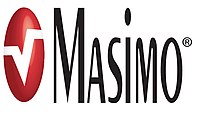Masimo
 |
|
| Public | |
| Traded as |
NASDAQ: MASI S&P 400 Component |
| Industry |
Medical Technology Medical Devices Medical Equipment |
| Founder | Joe E. Kiani |
| Headquarters | Irvine, California, United States of America |
|
Area served
|
Worldwide |
| Revenue | US $547.2 million |
|
Number of employees
|
3,500 (2014) |
| Website | www |
Masimo is an American Irvine, California-based manufacturer of noninvasive patient monitoring technologies. The company sells more pulse oximetry to hospitals than any other company. Masimo was founded in 1989 by electrical engineer Joe Kiani, who was later joined by fellow engineer Mohamed Diab. Masimo invented measure-through motion and low perfusion pulse oximetry, known as Masimo SET (Signal Extraction Technology). Masimo has been recognized for its intellectual property and for being one of the most innovative companies in the medical device industry. The company went public in 2007 and is currently traded on the NASDAQ stock exchange under the symbol MASI. In 2011, Forbes named Masimo to its list of top 20 public companies under a billion dollars in revenue, based on earnings growth, sales growth, and return on equity. In 2012, Joe Kiani, founder, CEO and Chairman of the Board was named the Ernst & Young National Entrepreneur of the Year - 2012 Life Sciences Award Winner. Kiani was recognized for "revolutionizing the health care industry by taking risks to create and commercialize noninvasive patient monitoring devices, which include an array of sensors that lead to improved accuracy, a reduction in the overall number of false readings, and ultimately, reduced cost of care."
Pulse oximetry uses two light emitting diodes (LEDs), one red and one infrared, to measure the absorption of light and translates that into the percentage of hemoglobin molecules that are bound with oxygen, which is called arterial oxygen saturation (SpO2). Conventional pulse oximetry assumes that arterial blood is the only blood moving (pulsating) in the measurement site. However, during patient motion, the venous blood also moves, which can cause conventional pulse oximetry to under-read SpO2 levels because it cannot distinguish between the arterial and venous blood. SET identifies the venous blood signal (which has a lower oxygen saturation level than arterial blood), isolates it, and uses adaptive filters to cancel the noise and extract the arterial signal in order to report accurate SpO2 and pulse rate. In addition, SET pulse oximetry provides perfusion index (PI) and pleth variability index (PVI). Multiple studies have shown that compared to non-SET pulse oximeters, SET increases the ability to detect life-threatening events and reduces false alarms during challenging conditions. Additional studies have also shown the impact of SET on patient outcomes, such as helping clinicians:
...
Wikipedia
